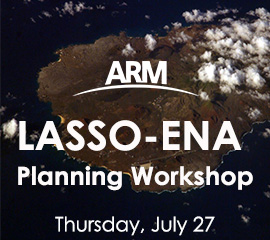 The Large-Eddy Simulation (LES) ARM Symbiotic Simulation and Observation (LASSO) activity is now beginning development of its third scenario, which will focus on marine boundary-layer clouds at the Atmospheric Radiation Measurement (ARM) user facility’s Eastern North Atlantic (ENA) atmospheric observatory.
The Large-Eddy Simulation (LES) ARM Symbiotic Simulation and Observation (LASSO) activity is now beginning development of its third scenario, which will focus on marine boundary-layer clouds at the Atmospheric Radiation Measurement (ARM) user facility’s Eastern North Atlantic (ENA) atmospheric observatory.
For those who would like to provide input on the development of the upcoming scenario, the LASSO team will host a virtual planning workshop from 9 to 11:30 a.m. Pacific on Thursday, July 27, 2023, on Zoom. Registration for the planning workshop is now open.
LASSO uses LES modeling to provide representative fine-scale flow fields and other details to supplement the suite of observations acquired by ARM. These simulations are vetted using ARM observations and provided to the community to further research on environmental and physical processes that are important for improving climate models as well as other research topics associated with ARM data.
To date, the LASSO team has released a scenario focused on shallow convection at ARM’s Southern Great Plains atmospheric observatory and is in the process of releasing a new scenario (currently in beta release) focused on deep convective initiation and storm dynamics during the Cloud, Aerosol, and Complex Terrain Interactions (CACTI) field campaign.
The upcoming LASSO-ENA scenario is anticipated to focus on marine stratocumuli with a scientific focus on precipitation processes. This is based on input garnered from the LASSO Expansion Workshop held in 2019. With the experience gained producing the first two scenarios combined with scientific advances since that workshop, the LASSO team will be gathering community input to ascertain whether the earlier suggestions are still the highest priority. The team also seeks input on how best to design the modeling strategy to meet as many goals as possible within the available computational and storage resources.
Register for the LASSO-ENA planning workshop.
# # #This work was supported by the U.S. Department of Energy’s Office of Science, through the Biological and Environmental Research program as part of the Atmospheric System Research program.

